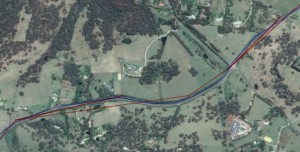There are many causes of zig zag errors in APRS tracks, and they fall generally into two main categories:
- incorrect positions (ie the tracker was never there); and
- correct positions with incorrect timestamps.
The first is common and has a number of causes, but principally defects in software used in iGates, most of which is not maintained either by the iGate operator or original developer. APRS is pretty static, but most old software has significant defects.
The second category is again common, and mostly the result of the design of the APRS radio network and its vulnerability to network delays (some of which can be caused by defective equipment).
This article looks at a case in the second category where a vehicle appears to have done a U-turn on the highway, travelled back some distance then another U-turn and caught up their original track speed at the next posit. It is clearly an out of order packet. This article shows how to diagnose the cause from the raw packet log for the tracker.

Above is a map of the glitch that is not uncommon in APRS for one of several reasons. No, VK2HJ has not done U-turns on the highway, the zig zag track is incorrect. Continue reading Zig zags in APRS tracks
Last update: 31st October, 2015, 7:24 AM








